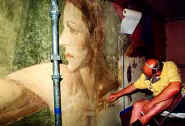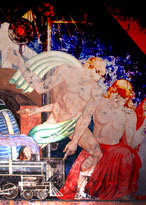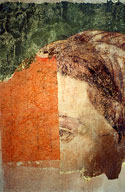Progress on the Conservation Treatments
of the
Carlo Ciampaglia Murals
Fair Park
Dallas, Texas
As the cleaning began, this is what the art conservators found:
 At the time the murals were obliterated, they had been exposed to the harsh Texas weather for about 6 years. Those murals which were better protected faired better than those that received the most direct sunlight. Many of the colors that Ciampaglia used were sensitive to light and either faded or turned to powder. The dark blues appear to have been the most unstable. It is our estimation that in 1942, when the murals were painted out, that one could run his hand across the blue painted areas and end up with a blue powdered hand.
At the time the murals were obliterated, they had been exposed to the harsh Texas weather for about 6 years. Those murals which were better protected faired better than those that received the most direct sunlight. Many of the colors that Ciampaglia used were sensitive to light and either faded or turned to powder. The dark blues appear to have been the most unstable. It is our estimation that in 1942, when the murals were painted out, that one could run his hand across the blue painted areas and end up with a blue powdered hand.
Actually, the murals have been through much more turmoil than just being obliterated: The overpaint of 1942 was a very hard lead based paint. The quality of paint was probably chosen for its covering power. On the West portico of the Centennial Building and on its medallions, this very hard paint layer was green. On the murals along the Esplanade the overpaint was light yellow. On the Food and Fiber Building it was brown.
 The overpainted murals were then left for many years (about 12 years or more) and the overpaint began to flake off and peel. The flaking peeled off original color and left original colors to be further exposed to the sun.
The overpainted murals were then left for many years (about 12 years or more) and the overpaint began to flake off and peel. The flaking peeled off original color and left original colors to be further exposed to the sun.
Before the next repainting of the walls occurred, the flaking on the walls was sealed with a linseed based varnish. This varnish was slathered over all exposed paint layers including original paint. At least one coat, probably two layers of an acrylic paint were then used to repaint the walls. This was probably done after 1954.
In the early 60’s the walls were painted again after more flaking had occurred. Repainting of the walls may have occurred every decade since then. This would account for the 6 – 8 layers of paint over the murals.
Some mural’s paint layers were flaking badly at the time this project began. Others paint layers were stable.
How the art conservators cleaned the murals:
 The cleaning process began in January 2000. A crew of 5 very experienced conservators and technicians began the discovery process of trying to unravel the puzzle of what would clean off the top layers of overpaint and not remove the original layers of paint. Three of this team has just completed another project (click here for info on other project) where the same work was required on 2000 sq. ft. of murals.
The cleaning process began in January 2000. A crew of 5 very experienced conservators and technicians began the discovery process of trying to unravel the puzzle of what would clean off the top layers of overpaint and not remove the original layers of paint. Three of this team has just completed another project (click here for info on other project) where the same work was required on 2000 sq. ft. of murals.
The materials/solvents finally decided upon were somewhat fickle in that with the cold winter temperatures, they acted differently than when the weather warmed up. So, in the beginning, cleaning on a cloudy day was timed differently than the cleaning on a sunny day.
Protecting the murals during treatments and in all kinds of weather is one of the mandates of the contract to do this work. Therefore, enclosures were constructed to close in the porticoes where heating, and later air conditioning, helped to equalize the ambient temperatures and provide a more stable environment and predictable treatment result.
The cleaning process was a complicated process that changed from one square foot to another depending on the thickness of the overpaint, the previous flaking that had occurred, and whether that area had been exposed to direct sun. Generally though, the process involved the application of a solvent based gel that swelled the overpaint overnight. Because there is was difference between the overpaint and the original paint, the swelling would occur on the overpaint but not on the original. Nevertheless, the original paint was softened in the process and in the case of the most sensitive colors, was directly effected by the overpaint swelling. Therefore, extreme care was taken during the removal of the swelled overpaint, to remove ONLY the overpaint. Sometimes, this was not possible and residual colors from original layers would come off. There were many different removal techniques that were employed to minimize the damage to the originial paint, especially in areas where the original paint was very badly deteriorated previously.
As of August 15, 2000 the cleaning stage of the project had been accomplished. The murals were revealed for the first time since 1942. However, while discovering these beautiful works of art, we have created another problem.
What’s next:
While the murals were covered, they were protected from the sun. Now that they are in view, they are also subject to fading etc. Therefore a “sun abatement” issue is now being developed. Interim shade screen will be temporarily installed while a permanent plan is established.
The retouching process in art conservation is often called “inpainting” because extreme care is taken to respect the original artwork. Paint is placed only where original paint is missing. Therefore the inpainting process really has no creative element. In fact, while art conservation requires connoisseurship it rarely requires the creative talent of artists. The art conservators and technicians will be inpainting on the murals through the end of November 2000.
Scott M. Haskins
